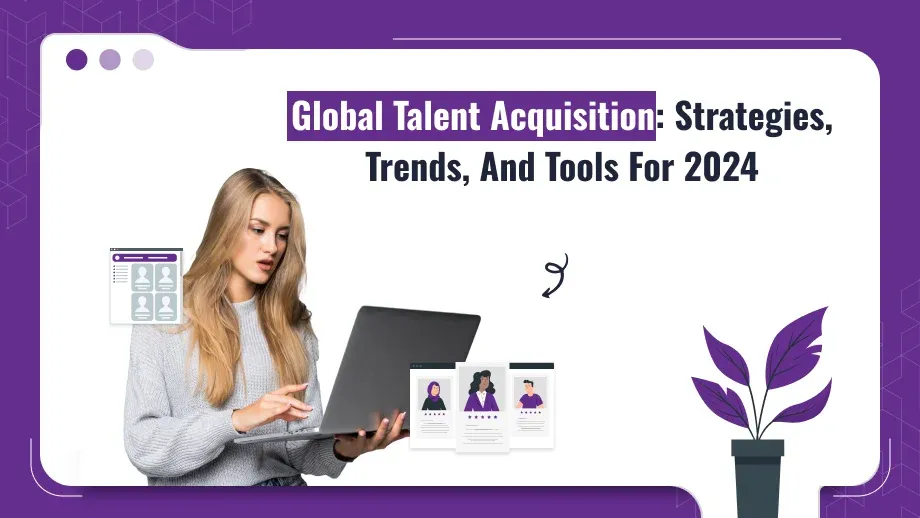
It can very well become a very global talent acquisition part of the recruitment mix for businesses that wish to outplay their competitors, given how today’s world is connected. To the HR managers, CHROs, and CEOs, hiring beyond borders means accessing the rest of the best talent pool and ensuring a competitive edge in finding them.
So, what exactly is global talent acquisition, and how do you build a talent acquisition strategy that taps into global talent? This guide gives you the top strategies and tools for 2024 so you stay on course for success.
What is Global Talent Acquisition?
Global talent acquisition means finding and attracting the best talent from various parts of the world. This is where you cast a very wide net and tackle the working-professional deficit regardless of the location. With digitalization, applicants have never been more accessible, and with the use of Applicant tracking systems (ATS), companies are now diligently scouting the globe for global talent to drive innovation diversity, and business growth.
Benefits of Global Talent Acquisition
Deeper Access to Talent Pool: Recruitment outside of an immediate geographic location provides an ability to tap into a higher-order diversity of skill sets and knowledge around the globe. It is truly ideal for niche or high-demand jobs because there is an inferior amount of local talent.
More Innovative Mind:: Interaction with different cultures and perspectives encourages innovation and creativity. Global companies have new ideas and different ways of approaching challenges.
Scalability and Flexibility: Having a strategy in talent acquisition enables you to scale up or down depending on the market fluctuation.
Cost Efficiency: Sometimes employing all around the globe can be cheaper for you. For example, recruiting or hiring remote employees from regions that have cheaper labor costs would come in as a cost-effective solution without having to compromise on quality.
The Top 7 Global Talent Acquisition Strategies For 2024
Go Remote-First
Remote work has changed global hiring. Businesses no longer need to limit recruitment to a specific location. A remote-first recruitment approach means the organization focuses on finding the right skills, wherever the candidate is based. This also makes the company more attractive to talent that wants flexible work environments.
Diversity, Equity, and Inclusion in Hiring
Building a globally diverse workforce is no longer a buzzword but a talent acquisition strategy. As long as diversity, equity, and inclusion accents are put on recruitment, companies are encouraged to reach out to diverse candidates and to be inclusive at work. Update your job posts to reach the groups you have yet to represent and eliminate bias with AI in the hiring process.
Use Applicant Tracking Systems for Global Reach
An applicant tracking system is an essential technology in global recruitment. The system enables one to monitor applicants track communications with candidates and facilitate smooth hiring processes within various geographies. Modern talent manager software enables one to make insightful hiring decisions based on data-driven metrics, such as candidate engagement and pipeline health.
Tailor Your Employer Brand for Global Appeal
This is by far the most significant concept behind global recruitment: employer branding. Companies ought to portray an attractive image to candidates from various regions, projecting a culture with diversity and growth opportunities. Content for each region, including localized career pages and recruitment strategies that speak to regional values can make a big impact on how potential candidates perceive your company.
Use AI and Automation to Simplify Global Hiring
To manage vast databases of candidate information, AI-powered talent acquisition tools are fast becoming the only way to tackle this when dealing with massive pools of global talent. AI aims to source, screen, and rank candidates by minimum bias with a required set of skills and experience while automation reduces the hiring cycle by automating tasks like scheduling interviews, sending follow-up emails, and processing hiring requisitions.
Focus on Strategic Partnerships
Local recruitment agencies or Recruitment Process Outsourcing firms can be good partners, yielding insight into local talent markets. Local recruitment agencies are familiar with the local law, compliance, and cultural requirements, which will help guide your HR operations so that you hire remote talent fast without much operational risk.
Data-Driven Talent Acquisition
Data in recruitment has transformed the way organizations go about talent acquisition. With the data, organizations can create forecasts of hiring trends, analyze the health of the talent pipeline, and evaluate sourcing strategies as well. This is a strategic talent acquisition – no waste and a focus on those candidates who will be successful.
Elevate Your Business with Global Talent Acquisition!
Seamlessly recruit top talent from around the world and build a diverse, innovative team to drive your success.
Why Do Companies Need a Global Talent Acquisition Strategy?
Access to a Larger, More Skilled Global Talent Pool
No doubt, the most obvious reason for having a global talent strategy is that one gains a much larger talent pool globally. Limiting recruitment of employees from a specific region can mean skill shortages or the inability to fill highly specialized roles. Companies will access varied areas of expertise, diverse skill sets, and innovative thinking anywhere in this world by having a broader cast net. As a result, you can have a global talent-hiring plan; you’re not going to miss out on the cream of the crop in regions with higher levels of AI, niche engineering, and data science skills, for example.
Diversity, Equity, and Inclusion
Diversified and inclusive teams have indeed turned out to be the only determinant for organizations to innovate better and improve decision-making. Employees originating from diverse cultural, educational, and professional backgrounds offer an opportunity for the sharing of new ideas and perspectives. Strategies of diversity and inclusion talent acquisition help reflect the global customer base more accurately and enhance brand image and market relevance.
Adapting to the Rise of Remote Work
Remote work has entirely changed the way a business approaches recruitment. While their locations are no longer a limitation in locating talent, whether it’s to hire remote workers with special skills to help companies with different functions or minimize operational costs by tapping into a more affordable region, remote work is one of the biggest drivers of global talent acquisition. With remote work, businesses do not have to geographically relocate employees to fill skill gaps.
Using Technology for Strategic Hiring
Applicant Tracking Systems and talent manager software make global recruitment much easier to handle. They help the HR teams filter applicants from other regions, automate mundane tasks such as scheduling interviews, and make sure hiring teams comply with regional labor laws and regulations. By integrating these systems into your talent acquisition strategy you will streamline your hiring process and bring in global top talent.
Overcoming Local Talent Shortages
Some challenges in finding talent may exist due to local talent shortages in certain locations. You can circumvent such local talent shortages by having a global talent acquisition strategy. This will allow you more flexibility to hire internationally, which may be significant, especially in areas like tech, healthcare, and engineering, where certain skill sets may exist in one part of the world but are in short supply elsewhere.
For example, India is a talent powerhouse today, while various regions in Eastern Europe and Southeast Asia are specific to certain expertise in engineering and software development. Outsourcing in these regions means you simply do not miss out on talent that would hold you back.
Managing Costs and Resources
Another strength of strategic talent acquisition is cost management. A company would be able to minimize overheads due to the acquisition of labor in areas where the cost of labor is low while keeping the standards high. Acquisition of talent through remote hiring negates relocation costs as well as some other logistical costs associated with the traditional local hiring manner.
Keeping up with Global Workforce Trends
Global talent acquisition, therefore, enables companies to move at the forefront of evolving workforce trends. New technologies and industries gain acceptance with time. And with every passing day, the interest in a new set of skills is mushrooming with the evolution of new technologies or an increasing new industry that may have gained popularity in one region. Having a strategic talent acquisition plan that focuses on global recruitment, you’ll be agile and respond promptly to changes in the global job market.
Employee Referrals in Global Talent Acquisition
Global Networks:
Employees working in different regions or with international backgrounds often have networks across multiple countries. Encourage these employees to refer candidates from their networks and you can exponentially expand your reach into a diverse global talent pool. You can source candidates from areas you wouldn’t normally target, including untapped talent markets.
Cultural Fit and Pre-Screening:
When an employee refers someone they know they will have a good sense of whether that person will fit the company culture. In global hiring where cultural differences can be a challenge this pre-screening by a current employee is especially valuable. It means candidates not only have the right skills but are also likely to thrive in the company’s work environment regardless of where they are based.
Time-to-Hire and Cost-per-Hire:
Globally, overall traditional recruitment practices are time-consuming and become too expensive. Employee referrals accelerate the hiring process, and the employees referred tend to move through the hiring stages faster compared to those coming from traditional sources, thus saving time-to-hire and cost-per-hire. Referred employees reportedly take less time to hire and generally stay longer than others sourced using other channels, as found by LinkedIn.
Higher Retention Rates:
Referred employees have higher retention rates. This is of particular importance in it, where recruiting from outside the country is very expensive and time-consuming. In the short run, referrals who have been brought by an existing employee would be already quite familiar with the prevailing culture and expectations of the company, leading to higher job satisfaction and retention rates in the long run.
Global Talent Acquisition Challenges
Global hiring does have many advantages. However, one also needs to be cognizant of the drawbacks:
- International Laws: Visa requirements, tax laws, and regulations on employment visa may differ from country to country; therefore, any hint at knowing how to go around these issues would be a pretty stiff test. Avoiding unnecessary legal entanglements would be ascertained by getting into compliance with the local laws of each country.
- Cultural Differences: Global hiring requires one to understand the regional cultures and work ethics. In another country, what works in one may not work. Therefore, your recruitment strategy mustn’t remain static and respect such differences.
- Employer Brand Consistency: Though you tailor your employer brand to different regions, maintaining consistency between global teams puts you aligned with the company’s mission and value.
Global Talent Acquisition Tools
- Talent Manager Software: Helps organize and streamline the recruitment process through better management of talent pipelines, application tracking, and automated communication.
- Applicant Tracking Systems (ATS): As stated, the most important for international recruitment is ATS, which helps process more in less time through HR teams.
- International Job Boards and Websites: Offers through international job boards like LinkedIn, Glassdoor, or Indeed attract international candidates.
- Video Interviewing Platforms: HireVue and other such tools like Zoom, and Microsoft Teams help in the video interview process, thereby saving time and money.
Measuring Success in Global Talent Acquisition
To measure the success of your strategic talent acquisition you have to track:
- Time-to-Hire: This is considered the time it takes to fill a certain position. How you reduce time-to-hire is tied to how you keep the very best talent engaged.
- Cost-per-Hire: This is considered the cost involved in sourcing, interviewing, and onboarding.
- Quality of Hire: How effective the new hire works at his job versus what expectations were when he was selected.
These metrics can be used to measure the effectiveness of the hiring of global talent acquisition teams and leaders.
The Future of Global Talent Acquisition
The future would be determined by progression in technology development as well as change in workforce expectations also popularly known as remote work. This is because most companies go global regarding talent acquisition strategies; therefore, competition for top international talents will continue to increase.
Innovation in this new world will require HR leaders to be more aggressive in finding new tools and techniques, such as AI-powered ATS and talent manager software, to remain ahead of change and ahead of the competition. Building diverse and inclusive workforces will be at the core of companies that want to grow in the global market.
Summary
The new influences in 2024, such as technology, diversity, and specialisms, will change global talent acquisition. Organizations can expand their reach into a global workforce with strategic talent acquisition, using AI tools, and global inclusion. It is all about accessing, attracting, and retaining talent for the best-performing HR leaders across the globe.





